Shower Curtain Effect Solution Review or Shower Curtain Effect Solution Complaint
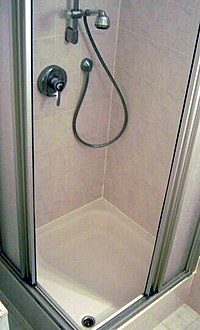

A combination shower and bathtub, with movable screen
A shower is a place in which a person bathes under a spray of typically warm or hot water. Indoors, there is a drain in the flooring. Nearly showers have temperature, spray pressure and adjustable showerhead nozzle. The simplest showers have a swivelling nozzle aiming down on the user, while more circuitous showers have a showerhead connected to a hose that has a mounting bracket. This allows the showerer to hold the showerhead by hand to spray the water onto unlike parts of their body. A shower can be installed in a small-scale shower stall or bathtub with a plastic shower curtain or door. Showering is common in Western civilisation due to the efficiency of using it compared with a bathtub. Its use in hygiene is, therefore, common practice.[one] [ folio needed ]
History
The original showers were neither indoor structures nor man-fabricated simply were mutual natural formations: waterfalls.[two] The falling h2o rinsed the bathers completely clean and was more efficient than bathing in a traditional bowl, which required manual transport of both fresh and waste water. Ancient people began to reproduce these natural phenomena past pouring jugs of water, oftentimes very cold, over themselves after washing. There has been bear witness of early upper class Egyptian and Mesopotamians having indoor shower rooms where servants would breast-stroke them in the privacy of their own homes.[3] Yet, these were rudimentary by modernistic standards, having rudimentary drainage systems and water was carried, not pumped, into the room. The aboriginal Greeks were the kickoff people to have showers. Their aqueducts and sewage systems made of atomic number 82 pipes allowed water to be pumped both into and out of big communal shower rooms used by elites and common citizens alike.[iv] These rooms have been discovered at the site of the city Pergamum and tin can also be found represented in pottery of the era. The depictions are very similar to modern locker room showers, and even included bars to hang up article of clothing.[5] [ folio needed ] The aboriginal Romans too followed this convention; their famous bathhouses (Thermae) tin can be found all around the Mediterranean and every bit far out as modern-solar day England. The Romans not only had these showers merely too believed in bathing multiple times a calendar week, if non every twenty-four hour period. The water and sewage systems developed past the Greeks and Romans broke downwards and fell out of use after the fall of the Roman Empire.
Modern showers
The first mechanical shower, operated by a mitt pump, was patented in England in 1767 by William Feetham,[ commendation needed ] a stove maker from Ludgate Loma in London. His shower contraption used a pump to force the water into a vessel higher up the user'due south caput and a chain would then be pulled to release the water from the vessel. Although the organization dispensed with the retainer labour of filling upward and pouring out buckets of water, the showers failed to grab on with the rich as a method for piping hot water through the system was not available. The system would too recycle the same dirty water through every cycle.
This early start was greatly improved in the anonymously invented English Regency shower design of circa 1810 (at that place is some ambiguity among the sources).[2] The original design was over ten feet (three yard) tall, and was fabricated of several metallic pipes painted to wait similar bamboo. A basin suspended above the pipes fed water into a nozzle that distributed the water over the user's shoulders. The water on the basis was drained and pumped back through the pipes into the basin, where the cycle would echo itself.[ citation needed ] The original epitome was steadily improved upon in the following decades until information technology began to gauge the shower of today in its mode of performance. Hand-pumped models became fashionable at i point as well as the use of adjustable sprayers for dissimilar h2o flow. The reinvention of reliable indoor plumbing around 1850[6] allowed free-standing showers to be connected to a running water source, supplying a renewable flow of water.[ citation needed ] Modern showers were installed in the barracks of the French army in the 1870s as an economic hygiene measure out, nether the guidance of François Merry Delabost, a French doctor and inventor.[7] Equally surgeon-general at Bonne Nouvelle prison in Rouen, Delabost had previously replaced private baths with mandatory communal showers for utilise by prisoners, arguing that they were more economical and hygienic.[8] First vi, and so viii shower stalls were installed. The water was heated past a steam engine and in less than v minutes, up to eight prisoners could wash simultaneously with only twenty litres of water. The French organisation of communal showers was adopted by other armies, the get-go being that of Prussia in 1879, and by prisons in other jurisdictions. They were as well adopted by boarding schools, before existence installed in public bathhouses. The offset shower in a public bathhouse was in 1887 in Vienna. In France, public bathhouses and showers were established by Charles Cazalet, firstly in Bordeaux in 1893 and and so in Paris in 1899.[nine]
Types
Domestic
Domestic showers are most usually stall showers or showers combined with a bathtub. A stall shower is a dedicated shower surface area which uses a door or curtain to contain water spray. The shower/tub format saves bathroom infinite and enables the area to be used for either a bath or a shower and commonly uses a sliding shower curtain or door to contain the water spray. Showers may also exist in a wet room, in which at that place is no independent shower area, or in a dedicated shower room, which does not crave containment of water spray. Domestic showers can have a unmarried shower head, multiple shower heads, handheld shower head(s) or other variations, all which may be adjustable as needed to varying degrees.
Public

Many modernistic athletic and aquatic facilities provide showers for employ past patrons, commonly in gender segregated changing rooms. These can be in the form of individual stalls shielded by defunction or a door or communal shower rooms. The latter are generally large open up rooms with any number of shower heads installed either directly into the walls or on posts throughout the shower area. Open showers are oft provided at public swimming pools and at pop beaches. War machine forces around the world set up field showers to enable the washing away of unsafe residue from modern weapons such every bit caustic chemicals, mortiferous biological agents, and radioactive materials, which can harm forces on both sides of a conflict.[ten]
Wet room
A moisture room often refers to a bath without internal defended or raised areas which has an open up shower. Structurally, a wet room requires the bathroom to have a gradient or slope towards a drain hole, and a foul air trap connecting the flooring to the waste product pipes. Depending on region, the term wet room tin can as well cover other rooms such every bit laundry rooms. In Kingdom of norway, for instance, whatsoever room with tap h2o and a bleed in the floor is considered a moisture room. Different jurisdictions often have special regulations apropos the pattern and structure of wet rooms to prevent damages from clammy air or water leakage, e.chiliad. mold. At that place are also often special regulations concerning electrical installations in wet rooms. For example, since water supplies often have their own electrical grounding, in that location can exist an added risk of injury associated to ground-faults, and some jurisdictions therefore require the installation of rest-current devices in wet rooms.
Other
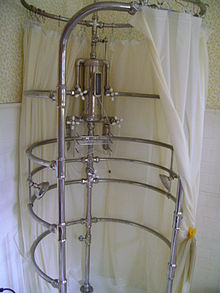
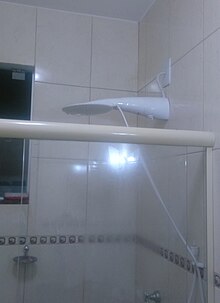
Brazilian electric shower
- Air shower, a type of bathing where high pressure air is used to blow off excess grit particles from cleanroom personnel.
- Digital shower, a shower organization that works in a like way to mixer or power showers, only provides more than control over the temperature of the water with the use of a digital control panel.
- Eco shower, a shower system that comes in mixer or electric variations, but likewise features a regulator to regulate the flow of water with a view to saving water.
- Electric shower, a shower stall device to locally heat shower h2o with electrical ability.
- Emergency showers, installed in laboratories and other facilities that use hazardous chemicals, are required by law in the U.s.;[11] designed to deluge continuously at effectually thirty–threescore Usa gallons (110–230 l) per infinitesimal [12] for at least 15 minutes [13] and should be located at nearly 10 seconds abroad from potential users.[xiv]
- Mixer shower, a shower system that takes water from existing hot and cold water supplies and combines them within the unit.
- Navy shower, a method of showering that allows for meaning conservation of h2o and energy.
- Power shower, a shower stall device that works similarly to a mixer shower by mixing existing hot and cold water feeds, but locally increases the h2o pressure available to the shower caput by means of an electric booster pump.
- Roman shower, a shower that does not use a door or curtain.
- Steam shower, a type of bathing where a humidifying steam generator produces steam that is dispersed around a person'south body.
- Vichy shower, a shower where large quantities of warm water are poured over a spa patron while the user lies inside a shallow (wet) bed, similar to a massage table, merely with drainage for the water.
Types of shower heads
- Fixed shower heads: Traditional fixed shower-heads are mostly common shower-faucets because they tin can easily connect to the plumbing fixtures without any additional hardware.
- Shower handsets: Manus-gear up shower-faucets are continued by a flexible hose, and tin can also exist mounted and used like a fixed shower-head.
- Ceiling-mounted faucets: Ceiling-mounted shower-faucets are typically pelting-drop shower-heads mounted in the ceiling of the shower. H2o rains down, at low or medium pressure, using gravity to shower on one from directly above.[15]
- Adjustable shower heads: Adjustable shower faucets ofttimes take numerous settings, including pulsating massage and low/medium/high-force per unit area menstruum settings.
- Shower panels: Unlike a single showerhead, these are wall-mounted with sprayers aimed horizontally at diverse parts of the body.
Utilise and environmental

Shower usage in the latter half of the 20th century skyrocketed. Personal hygiene became a primary business concern, and bathing every solar day or multiple times a day is common among Western cultures.[one] [ page needed ] Showering is more often than not faster than bathing and can use less water. In an average home, showers are typically the third largest h2o apply after toilets and clothes washers. The average American shower uses 17.ii U.s. gallons (65 l; 14.iii imp gal) and lasts for 8.2 minutes at an boilerplate flow rate of 2.ane US gallons (7.ix fifty; ane.seven imp gal) per infinitesimal.[sixteen] Showering is one of the leading means people use h2o in the home, accounting for nearly 17 pct of residential indoor water utilise, which roughly equals to 1,200,000,000 U.s. gallons (4.5×109 50; 1.00×tenix imp gal) of h2o annually only for showering.[17] The U.Southward. Environmental Protection Agency recommends to retrofit habitation showers with a shower head that uses less than ii United states of america gallons (seven.6 50; 1.7 imp gal) to conserve water. However, many have hypothesized reducing flow rates of showerheads might cause users to take much longer showers.[18] Other options to save h2o include using actress high pressure mist flow or design in sensors and valves to shut off or reduce water flow while people are not actively using the shower water.
Various measures can be taken to increase safety for those, especially elderly people, taking showers or baths.[19] When a person takes a shower may indicate their social position. Blue collar workers and children accept been found to be more likely to have a shower in the evening after piece of work and school, whereas white neckband workers accept been institute to shower in the morn earlier work.[ commendation needed ] Some people take more than than one shower each day, usually at their normal shower fourth dimension, and afterward exercising. People also shower to cool off in hot conditions, especially those unaccustomed to the climate.[xx] [ better source needed ] Used shower water tin be employed equally greywater.
Cultural significance
Showering is generally part of a daily routine primarily to promote cleanliness and preclude odor, disease and infection. Advances in science and medicine in the 19th century began to realize the benefit of regular bathing to an private's health. Equally a result, most modern cultures encourage a daily personal hygiene regimen. Showering has too developed the reputation as a relaxing and more often than not therapeutic activity.[1] [ page needed ]
Structure and blueprint
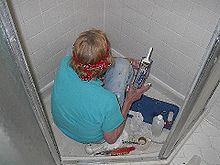
Repairing damaged tile in a shower stall with a caulking gun
Designs for shower facilities vary by location and purpose. There are gratis-standing showers, simply also showers which are integrated into a bathtub. Showers are separated from the surrounding area through watertight curtains (shower curtain), sliding doors, or folding doors, or shower blinds, in order to protect the space from spraying water. Showers with a level entry moisture room are becoming very popular, especially due to improvements in waterproofing systems and prefabricated components. Places such as a swimming pool, a locker room, or a military facility have multiple showers. There may exist communal shower rooms without divisions, or shower stalls (typically open at the tiptop). Many types of showers are available, including consummate shower units which are all encompassing showers that include the pan, walls, and often the shower head, as well equally pieced together units in which the pan, shower caput, and doors are purchased separately. Each blazon of shower poses dissimilar installation bug.
Installation
Though the installation requirements of each of shower will differ, the installation of a shower in general requires the laying of several h2o transportation pipes, including a pipe for hot h2o and for cold water, and a drainage piping. Information technology is important that the wet areas of a bathroom be waterproof, and multiple layers of waterproofing tin can exist employed. Grout is used to fill up gaps between tiles, simply grout and tile setting materials are by and large porous. Tiles are generally waterproof, though a shower pan must be installed beneath them as a rubber to prevent water leakage.[21] Thus modest mosaic tiles offer less of a defense than large format tiles. Sub-tile waterproofing is important when tiles are being used. Best practice requires a waterproofing cloth to cover the walls and floor of the shower area that are then covered with tile, or in some countries with a sheet textile like vinyl.
Drainage

Shower repair showing bleed piping with trap

This diverter valve near to be installed behind a shower mixes hot and cold water.
A shower may be equipped with a second emergency drain outside of the shower in instance of overflow. An emergency overflow bleed is required in Australia and some European countries.[ citation needed ]
Shower caput
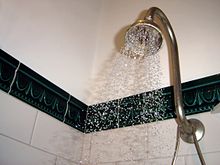
A shower head is a perforated nozzle that distributes water over solid angle a focal signal of use, generally overhead the bather. A shower uses less water than a full immersion in a bathroom. Some shower heads can exist adapted to spray different patterns of water, such as massage, gentle spray, strong spray, and intermittent pulse or combination modes. Difficult water may issue in calcium and magnesium deposits clogging the caput, reducing the menses and changing the spray pattern. For descaling, various acidic chemicals or brushes tin be used or some heads accept rubber-similar jets that can be manually descaled. A bootleg remedy is to immerse information technology in a solution of h2o and vinegar for a while, since the vinegar is able to dissolve limescale. Some governments effectually the world fix standards for water usage and regulate shower heads. For example, in the United States, residential and virtually commercial shower heads must catamenia no more than than 9.5 litres (ii.one imp gal; 2.5 US gal) per minute per the Section of Free energy ruling 10 CFR 430. Low-flow shower heads that have a water flow of equal or less than seven.half dozen litres (1.7 imp gal; ii.0 U.s. gal) per minute (2.0 gallons per minute), can apply water more than efficiently past aerating the water stream, altering nozzles through advanced catamenia principles or by high-speed oscillation of the spray stream. The US EPA administers a voluntary h2o saving programme, WaterSense, which tin certify low-period shower heads.
Shower and bathtub curtains
Curtains can be used in shower or bathtub enclosures with two main purposes: to provide privacy and to prevent h2o from flooding or spraying outside the shower or bathtub area. Shower and bathtub curtains usually environs the bath inside the tub or shower area and are held up with railings or drapery rods high on the wall or ceiling. To accommodate the different types of bathtub shapes, railings can come up in different sizes and are flexible in their pattern.
Some people utilize two shower curtains: ane that is inside the tub, which is mainly functional or decorative as well, and an outer shower pall, which is purely decorative. The bottom portion of the inner curtain ofttimes comes with magnetic discs or suction cups which adhere to the bathtub itself.
These curtains are usually fabricated from vinyl, fabric or plastic.
-
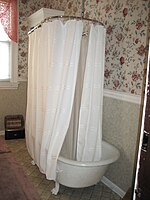
Bathtub mantle
-

Shower curtain
Shower and bathtub doors
Shower or bathtub doors are doors (besides chosen screens) used in bathrooms that help keep water inside a shower or bathtub and are alternatives to shower curtains. They are available in many different styles such as framed or frameless, sliding or swing. They are usually constructed of aluminium, clear drinking glass, plexiglass or tempered glass. Shower doors tin can come up in many different hardware finishes and glass patterns that can match other bathroom hardware such equally faucets and shower heads. There are too shower doors that are in a neo angle design for employ on shower pans that have the neo design every bit well. The design of the shower pan is extremely important every bit the shower door must be the type required for the pan in lodge to work. A shower door requires plastic lining along the edges of the door to protect against h2o leaking out.
-
-

Bathtub door.
Equipment
- Pressure level balanced valve, a device to provide constant shower h2o pressure and foreclose temperature fluctuations
- Shampoo
- Shower caddy, a storage system inside the shower, typically for shampoo, conditioner, lather and other related things
- Shower cap, a cap worn while showering or bathing, to protect hair from becoming moisture
- Shower radio, a radio that is waterproofed to allow it to be used in a bathroom or other wet environs
- Shower speaker, a trivial Bluetooth speaker designed to listen to music while showering
- Soap
- Washing mitt, a tool for applying soap to the trunk
- Water heat recycling units to reclaim much of the waste product h2o's oestrus and recycle information technology to the shower head and minimize rut lost to the drain
See also
- Bathing
- Bathroom
- Bathtub
- Douche
- Navy shower
- Solar heated shower
- Steam shower
- Transfer bench
- H2o recycling shower
Citations
- ^ a b c Shove 2004.
- ^ a b "The Stand up-Up Bathroom". theplumber.com. Archived from the original on xxx Nov 2010. Retrieved 5 December 2010.
- ^ James & Thorpe 1995, p. 460.
- ^ Humphrey, Olsen & Sherwood 1998, p. 280.
- ^ James & Thorpe 1995.
- ^ "History of Plumbing in America". Plumbing & Mechanical Magazine. July 1987. ISSN 8750-6041. Archived from the original on 6 November 2008. Retrieved 6 Jan 2011.
by 1845, the installation of sanitary sewers began to pay off ... In 1874, ... an unknown plumber solved the trouble of venting.
- ^ Biot, Roger (2005). Fameux Rouennais, Rouennais fameux. Rouen: PTC-Normandie. ISBN9782350380117.
- ^ Hervé Dajon, La douche, une invention d'un médecin des prisons, le docteur Merry Delabost, Criminocorpus, 2010 Online text - in French
- ^ Feltgen, Dr. (8 November 2000). "Dr. Merry Delabost, inventor of the shower?" (PDF). Hopitaux de Rouen. Archived from the original (PDF) on 12 January 2012. Retrieved 30 September 2012.
- ^ Jones 2004.
- ^ "1910.151: Occupational Safety and Health Standards — Medical services and start aid". Regulations (Standards - 29 CFR). Occupational Safety and Health Administration. 18 June 1998. Retrieved one June 2010.
- ^ Mayer 1995, p. 155.
- ^ Vincoli 2000, p. 343.
- ^ Brauer 2006, p. 533.
- ^ Rowan, Gerald; Sanford, Steve (2013). Compact Houses: 50 Creative Floor Plans for Efficient, Well-Designed Modest Homes. North Adams, Mass.: Storey Publishing. p. x. ISBN9781612121024.
- ^ "Indoor Water Apply". Alliance for Water Efficiency. Alliance for Water Efficiency. Archived from the original on 2018-10-24. Retrieved 30 October 2018.
- ^ "Showerheads". United States Environmental Protection Agency. Retrieved 30 October 2018.
- ^ "Indoor H2o Employ". Alliance for Water Efficiency. Archived from the original on 2018-10-24. Retrieved 30 Oct 2018.
- ^ Mullick 2005.
- ^ Take A Common cold Shower To Cool Off This Summertime Archived 2012-eleven-08 at the Wayback Machine, John Westenhaver, Energy Watcher, twenty June 2009
- ^ "Curbless Showers - An Installation Guide" (PDF). NC State University. Retrieved 18 Jan 2017.
Cited works and general references
- Books
- Brauer, Roger 50 B (2006). "Personal protective equipment". Safety and health for engineers (2nd ed.). John Wiley and Sons. ISBN978-0-471-29189-iii.
- Humphrey, John W; Olsen, John P; Sherwood, Andrew Northward (1998). Greek and Roman Technology: A Sourcebook. New York: Routledge. ISBN978-0-415-06136-0.
- James, Peter; Thorpe, Nick (1995). Aboriginal Inventions . New York: Ballantine. ISBN978-0-345-40102-one.
- Mayer, Leonard (1995). "Emergency systems". Pattern and planning of enquiry and clinical laboratory facilities. John Wiley and Sons. ISBN978-0-471-30623-8.
- Oxford New Desk Dictionary and Thesaurus (third ed.). New York: Berkley Publishing Grouping. 2009. ISBN978-0-425-22862-3. OCLC 276819901.
- Shove, Elizabeth (2004). Comfort, Cleanliness and Convenience The Social Organization of Normality (New Technologies/New Cultures). New York: Berg. ISBN978-1-85973-630-two.
- Vincoli, Jeffrey Westward (2000). Lewis' dictionary of occupational and environmental safety and health . CRC Press. ISBN978-i-56670-399-four.
- Web pages
- Jones, Jerry (29 October 2004). "Decontamination shower system revamped". Reporter. Nashville, TN: Vanderbilt University Medical Center. Retrieved five Dec 2010.
- Mullick, Abir (2005). "Bathing for Older people with Disabilities". UB School of Architecture and Planning. Retrieved v December 2010.
Source: https://en.wikipedia.org/wiki/Shower

0 Response to "Shower Curtain Effect Solution Review or Shower Curtain Effect Solution Complaint"
Post a Comment